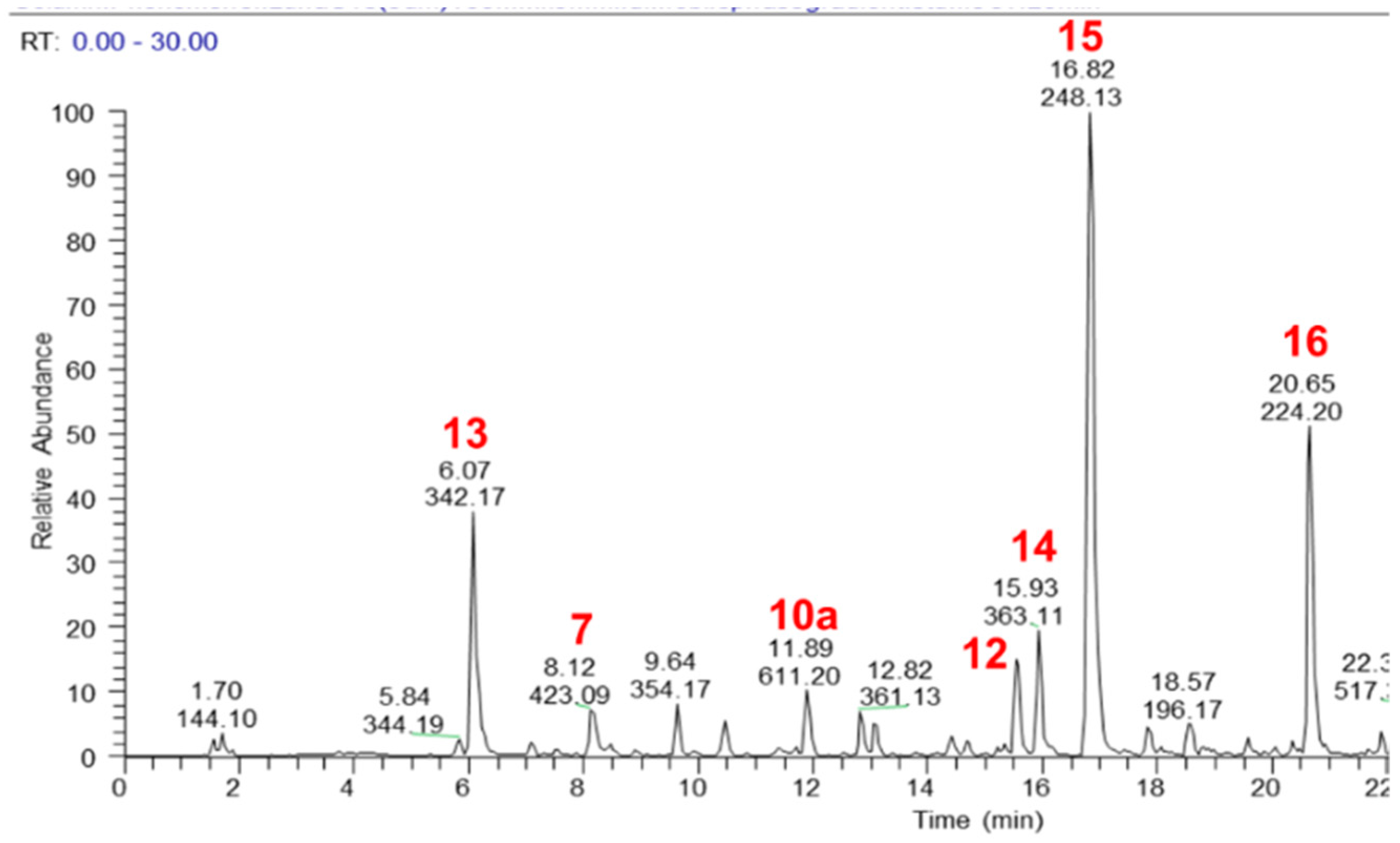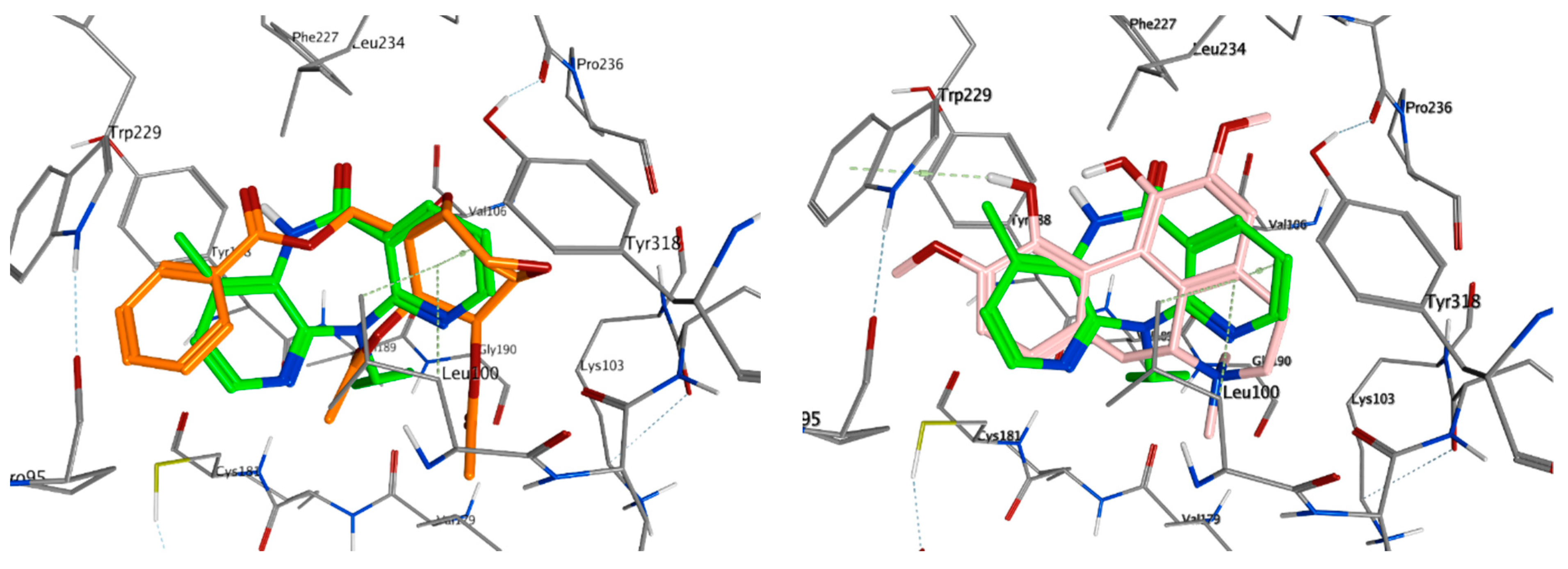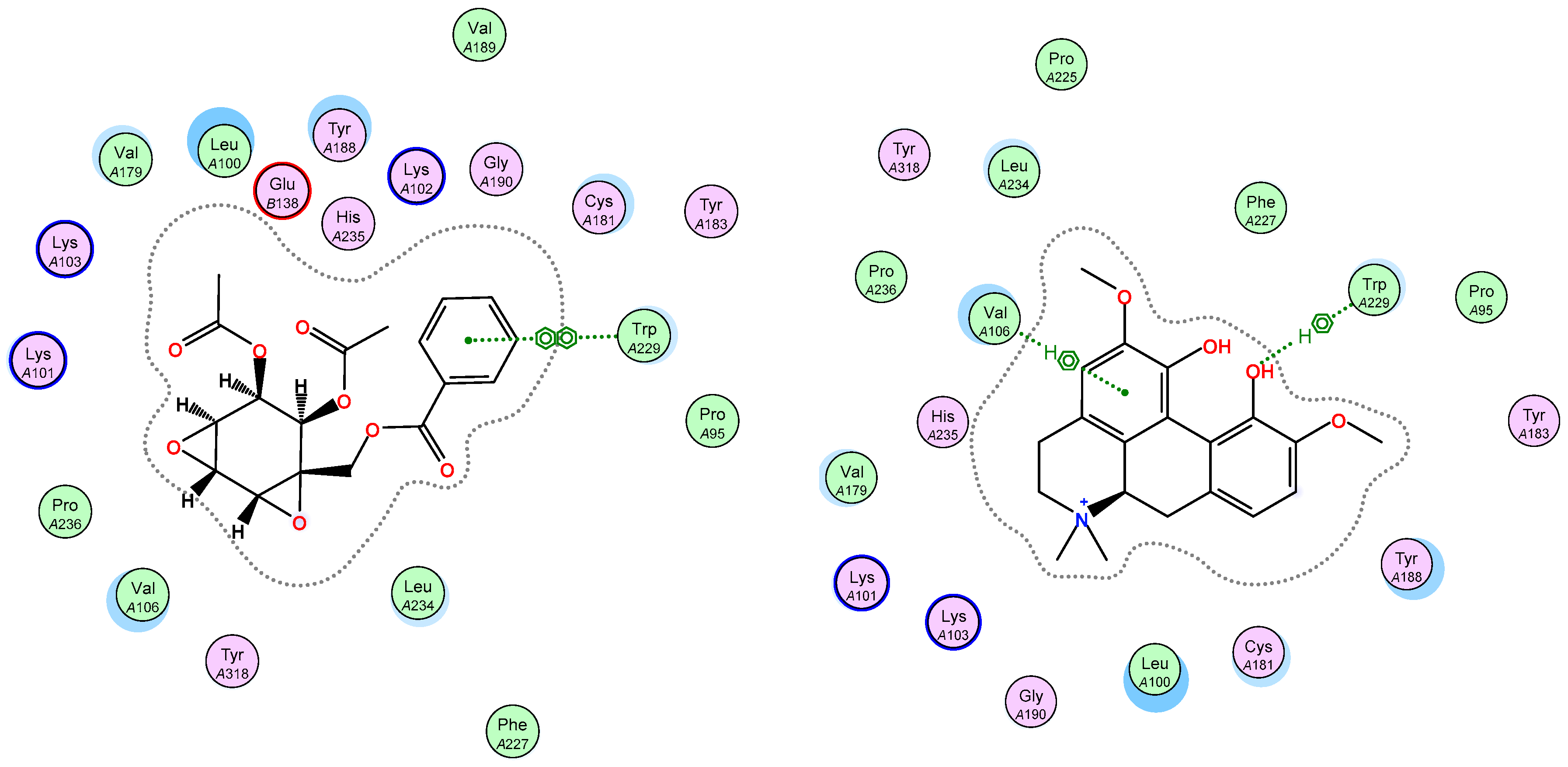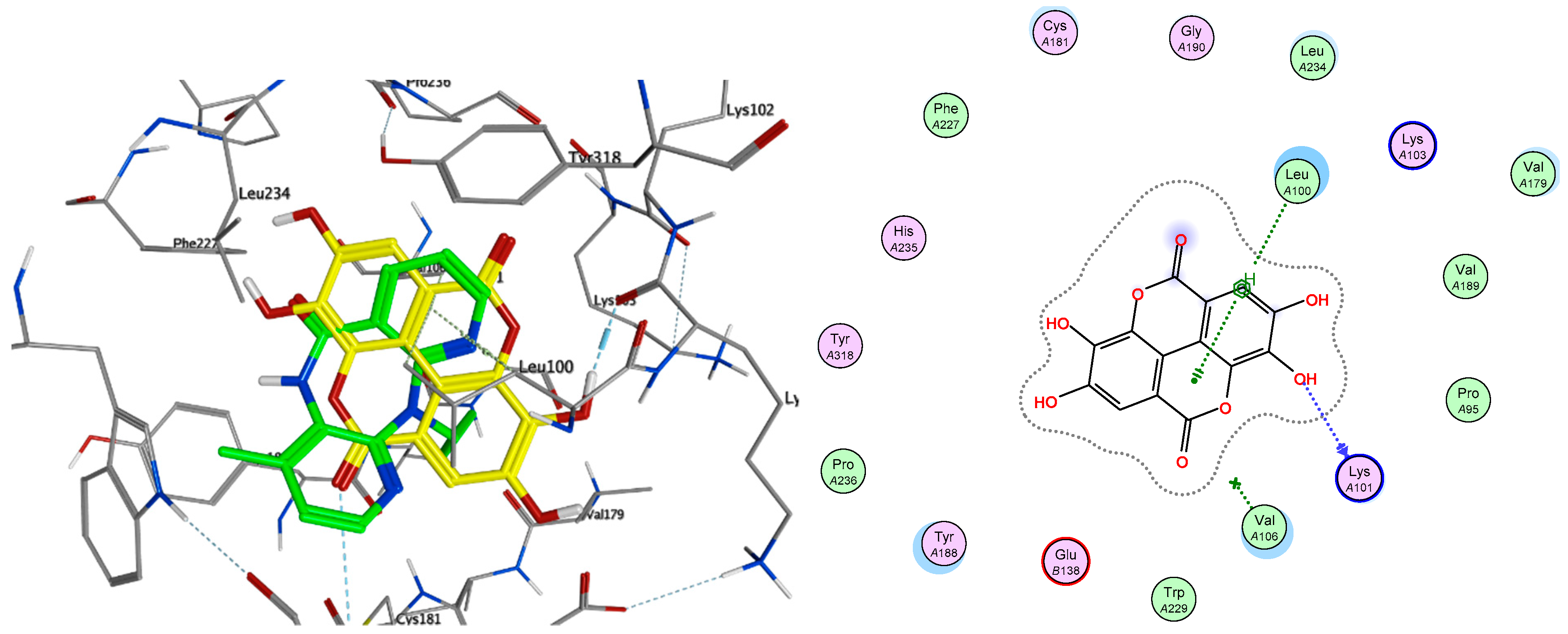HIV-1 Reverse Transcriptase Inhibition by Major Compounds in a Kenyan Multi-Herbal Composition (CareVid™): In Vitro and In Silico Contrast
Abstract
:1. Introduction
2. Results
2.1. Chemical Analysis
2.2. Docking Results
2.3. In Vitro Reverse Transcription Inhibition
3. Discussion
| Plant Name | Local Names | Plant Part | Traditional Use on HIV and Other Related Diseases | References |
|---|---|---|---|---|
| Acacia nilotica (L.) Willd. ex Delile | Chebitet | Stem bark | Chest pains, coughs, pneumonia, tuberculosis, coughs Gastrointestinal problems (diarrhoea) | [33] |
| Adenia gummifera (Harv.) Harms | Kinyelwet | Roots | Oral candidiasis, Respiratory infections (chest pains, colds, cough and tuberculosis), Sexually transmitted infections (gonorrhoea and venereal diseases) | [34,35,36,37,38] |
| Anthocleista grandiflora Gilg | Mosombobet | Stem bark | Chest pains | [39] |
| Asparagus africanus Lam. | Birirwapsot | Roots | Tuberculosis, venereal diseases | [40] |
| Bersama abyssinica Fresen. | Cheptorwoget | Stem bark | Sexually transmitted infections (gonorrhoea and venereal diseases) | [41] |
| Clematis hirsuta Guill. & Perr. | Bisingwet | Roots | Pain management Sexually transmitted infections (gonorrhoea and venereal diseases) | [42,43] |
| Croton macrostachyus Hochst. ex Delile | Tebeswuet | Stem bark | Sexually transmitted infections (gonorrhoea and venereal diseases) Chest problems | [44,45] |
| Clutia robusta Pax | Kurbanyat | Roots | Diarrhoea, gonorrhoea, chest pains | [45] |
| Dovyalis abyssinica (A.Rich.) Warb | Nukiat | Roots | Sexually transmitted infections (gonorrhoea and venereal diseases) Gastrointestinal problems | [46,47] |
| Ekebergia capensis Sparm | Arorwet | Stem bark | Respiratory problems (chest pains, cold, cough, respiratory complaints) Sexually transmitted infections (gonorrhoea and venereal diseases) Mouth sores | [48,49] |
| Periploca linearifolia Quart.-Dill. & A.Rich. | Sinendet | Roots | Cough and Pneumonia Sexually transmitted infections (gonorrhoea and venereal diseases), warts, Diarrhoea | [36] |
| Plantago palmata Hook.f. | Chepinderem | Whole plant | Sexually transmitted infections (gonorrhoea and venereal diseases) Gastrointestinal problems | [50] |
| Prunus Africana Hook.f. Kalkman | Tendwet | Stem bark | Prostate cancer, Benign prostate hypertrophy Chest infections Diarrhoea | [51,52] |
| Rhamnus prinoides L’Her. | Kosisitiet | Roots | Sexually transmitted diseases Respiratory infections Gastrointestinal infections Tuberculosis | [53,54,55] |
4. Materials and Methods
4.1. Sample Preparation
4.2. HPLC–MS Analysis
4.3. HIV-1 Reverse Transcriptase Inhibition Determination
4.4. Docking Methodology
Supplementary Materials
Author Contributions
Funding
Institutional Review Board Statement
Informed Consent Statement
Data Availability Statement
Acknowledgments
Conflicts of Interest
References
- Khumalo, G.P.; Sadgrove, N.J.; Van Vuuren, S.F.; Van Wyk, B.E. South Africa′s Best BARK Medicines Prescribed at the Johannesburg Muthi Markets for Skin, Gut, and Lung Infections: MIC’s and Brine Shrimp Lethality. Antibiotics 2021, 10, 681. [Google Scholar] [CrossRef] [PubMed]
- Haacker, M.; Birungi, C. Poverty as a barrier to antiretroviral therapy access for people living with HIV/AIDS in Kenya. Afr. J. AIDS Res. 2018, 17, 145–152. [Google Scholar] [CrossRef]
- UNAIDS. Fact Sheet—Latest Global and Regional Statistics on the Status of the AIDS Epidemic. Available online: https://www.unaids.org/en/resources/documents/2021/UNAIDS_FactSheet (accessed on 22 August 2021).
- Rege, A.; Dahake, R.; Roy, S.; Chowdhary, A. Screening of Natural Products for Anti-HIV Potential: An In vitro Approach. JOJ Immuno Virol. 2015, 1, 555556. [Google Scholar] [CrossRef]
- Cherutich, P.; Kim, A.A.; Kellogg, T.A.; Sherr, K.; Waruru, A.; De Cock, K.M.; Rutherford, G.W. Detectable HIV Viral Load in Kenya: Data from a Population-Based Survey. PLoS ONE 2016, 11, e0154318. [Google Scholar] [CrossRef] [Green Version]
- Lubinga, S.J.; Kintu, A.; Atuhaire, J.; Asiimwe, S. Concomitant herbal medicine and Antiretroviral Therapy (ART) use among HIV patients in Western Uganda: A cross-sectional analysis of magnitude and patterns of use, associated factors and impact on ART adherence. AIDS Care 2012, 24, 1375–1383. [Google Scholar] [CrossRef] [PubMed]
- Mamba, P.; Adebayo, S.A.; Tshikalange, T.E. Anti-microbial, anti-Inflammatory and HIV-1 reverse transcriptase activity of selected South African plants used to treat sexually transmitted diseases. Int. J. Pharmacogn. Phytochem. Res. 2016, 8, 1870–1876. [Google Scholar]
- Namuddu, B.; Kalyango, J.N.; Karamagi, C.; Mudiope, P.; Sumba, S.; Kalende, H.; Wobudeya, E.; Kigozi, B.K.; Waako, P. Prevalence and factors associated with traditional herbal medicine use among patients on highly active antiretroviral therapy in Uganda. BMC Public Health 2011, 11, 855. [Google Scholar] [CrossRef] [Green Version]
- Nlooto, M.; Naidoo, P. Clinical relevance and use of traditional, complementary and alternative medicines for the management of HIV infection in local African communities, 1989–2014: A review of selected literature. PULA Botsw. J. Afr. Stud. 2014, 28, 105–116. [Google Scholar]
- Mushiwokufa, W. Treating HIV Infection with Herbal Medicine: A Case Report. J. Tradit. Med. Clin. Naturop. 2016, 5, 1000192. [Google Scholar] [CrossRef]
- Onifade, A.A.; Jewell, A.P.; Ajadi, T.A.; Rahamon, S.K.; Ogunrin, O.O. Effectiveness of a herbal remedy in six HIV patients in Nigeria. J. Herb. Med. 2013, 3, 99–103. [Google Scholar] [CrossRef]
- Ndhlala, A.R.; Stafford, G.I.; Finnie, J.F.; van Staden, J. Commercial herbal preparations in KwaZulu-Natal, South Africa: The urban face of traditional medicine. S. Afr. J. Bot. 2011, 77, 830–843. [Google Scholar] [CrossRef] [Green Version]
- Chepkwony, P.C.; Medina, M.; Medina, M. Compounds and Compositions for Treating Infection. 20120190734A1, 26 January 2014. [Google Scholar]
- Medina, M.; Chepkwony, P.C.; Medina, M. Medicinal and Herbal Composition and Uses Thereof. U.S. Patent 8404284B2, 23 December 2010. [Google Scholar]
- Kloos, H.; Mariam, D.H.; Kaba, M.; Tadele, G. Traditional medicine and HIV/AIDS in Ethiopia: Herbal medicine and faith healing: A review. Ethiop. J. Health Dev. 2013, 27, 141–155. [Google Scholar]
- Chinsembu, K.C. Chemical diversity and activity profiles of HIV-1 reverse transcriptase inhibitors from plants. Braz. J. Pharm. 2019, 29, 504–528. [Google Scholar] [CrossRef]
- Ahn, M.J.; Yoon, K.D.; Min, S.Y.; Lee, J.S.; Kim, J.H.; Kim, T.G.; Kim, S.H.; Kim, N.G.; Huh, H.; Kim, J. Inhibition of HIV-1 reverse transcriptase and protease by phlorotannins from the brown alga Ecklonia cava. Biol. Pharm. Bull. 2004, 27, 544–547. [Google Scholar] [CrossRef] [PubMed] [Green Version]
- Figiel, M.; Krepl, M.; Park, S.; Poznanski, J.; Skowronek, K.; Golab, A.; Ha, T.; Sponer, J.; Nowotny, M. Mechanism of polypurine tract primer generation by HIV-1 reverse transcriptase. J. Biol. Chem. 2018, 293, 191–202. [Google Scholar] [CrossRef] [PubMed] [Green Version]
- Sluis-Cremer, N. Future of nonnucleoside reverse transcriptase inhibitors. Proc. Natl. Acad. Sci. USA 2018, 115, 637–638. [Google Scholar] [CrossRef] [PubMed] [Green Version]
- Poongavanam, V.; Namasivayam, V.; Vanangamudi, M.; Shamaileh, H.A.; Veedu, R.N.; Kihlberg, J.; Murugan, N.A. Integrative approaches in HIV-1 non-nucleoside reverse transcriptase inhibitor design. WIREs Comput. Mol. Sci. 2017, 8, e1328. [Google Scholar] [CrossRef]
- Tian, L.; Kim, M.S.; Li, H.; Wang, J.; Yang, W. Structure of HIV-1 reverse transcriptase cleaving RNA in an RNA/DNA hybrid. Proc. Natl. Acad. Sci. USA 2018, 115, 507–512. [Google Scholar] [CrossRef] [Green Version]
- Wei, S.D.; Zhou, H.C.; Lin, Y.M. Antioxidant activities of fractions of polymeric procyanidins from stem bark of Acacia confusa. Int. J. Mol. Sci. 2011, 12, 1146–1160. [Google Scholar] [CrossRef] [Green Version]
- Al-Nour, M.Y.; Ibrahim, M.M.; Elsaman, T. Ellagic Acid, Kaempferol, and Quercetin from Acacia nilotica: Promising Combined Drug with Multiple Mechanisms of Action. Curr. Pharmacol. Rep. 2019, 5, 255–280. [Google Scholar] [CrossRef] [Green Version]
- Sharma, B.; Yadav, A.; Dabur, R. Interactions of a medicinal climber Tinospora cordifolia with supportive interspecific plants trigger the modulation in its secondary metabolic profiles. Sci. Rep. 2019, 9, 14327. [Google Scholar] [CrossRef]
- Tane, P.; Tatsimo, S.; Conolly, J.D. Crotomacrine, a new clerodane diterpene from the fruits of Croton macrostachyus. Tetrahedron Lett. 2004, 45, 6997–6998. [Google Scholar] [CrossRef]
- Rasmussen, B.; Nkurunziza, A.-J.; Witt, M.; Oketch-Rabah, H.A.; Jaroszewski, J.W.; Staerk, D. Dovyalicin-type spermidine alkaloids from Dovyalis species. J. Nat. Prod. 2006, 69, 1300–1304. [Google Scholar] [CrossRef]
- Sinan, K.I.; Chiavaroli, A.; Orlando, G.; Bene, K.; Zengin, G.; Cziaky, Z.; Jeko, J.; Mahomoodally, M.F.; Picot-Allain, M.C.N.; Menghini, L.; et al. Biopotential of Bersama abyssinica Fresen Stem Bark Extracts: UHPLC Profiles, Antioxidant, Enzyme Inhibitory, and Antiproliferative Propensities. Antioxidants 2020, 9, 163. [Google Scholar] [CrossRef] [PubMed] [Green Version]
- Smerdon, S.J.; Jager, J.; Wang, J.; Kohlstaedt, L.A.; Chirino, A.J.; Friedman, J.M.; Rice, P.A.; Steitz, T.A. Structure of the binding site for nonnucleoside inhibitors of the reverse transcriptase of human immunodeficiency virus type 1. Proc. Natl. Acad. Sci. USA 1994, 91, 3911–3915. [Google Scholar] [CrossRef] [PubMed] [Green Version]
- Kohlstaedt, L.A.; Wang, J.; Friedman, J.M.; Rice, P.A.; Steitz, T.A. Crystal structure at 3.5 A resolution of HIV-1 reverse transcriptase complexed with an inhibitor. Science 1992, 256, 1783–1790. [Google Scholar] [CrossRef] [PubMed] [Green Version]
- Ren, J.; Nichols, C.; Bird, L.; Chamberlain, P.; Weaver, K.; Short, S.; Stuart, D.I.; Stammers, D.K. Structural mechanisms of drug resistance for mutations at codons 181 and 188 in HIV-1 reverse transcriptase and the improved resilience of second generation non-nucleoside inhibitors. J. Mol. Biol. 2001, 312, 795–805. [Google Scholar] [CrossRef] [PubMed]
- Das, K.; Martinez, S.E.; Bauman, J.D.; Arnold, E. HIV-1 reverse transcriptase complex with DNA and nevirapine reveals non-nucleoside inhibition mechanism. Nat. Struct Mol. Biol. 2012, 19, 253–259. [Google Scholar] [CrossRef] [Green Version]
- Hevener, K.E.; Zhao, W.; Ball, D.M.; Babaoglu, K.; Qi, J.; White, S.W.; Lee, R.E. Validation of molecular docking programs for virtual screening against dihydropteroate synthase. J. Chem. Inf. Model. 2009, 49, 444–460. [Google Scholar] [CrossRef] [PubMed]
- Rather, L.J.; Shahid-ul-Islam, S.; Mohammad, F. A review of its traditional uses, phytochemistry, and pharmacology. Sustain. Chem. Pharm. 2015, 2, 12–30. [Google Scholar] [CrossRef]
- Barbosa, F.; Hlashwayo, D.; Sevastyanov, V.; Chichava, V.; Mataveia, A.; Boane, E.; Cala, A. Medicinal plants sold for treatment of bacterial and parasitic diseases in humans in Maputo city markets, Mozambique. BMC Complement. Med. Ther. 2020, 20, 19. [Google Scholar] [CrossRef]
- Chhabra, S.C.; Mahunnah, R.L.A.; Mshiu, E.N. Plants used in traditional medicine in Eastern Tanzania. V. Angiosperms (Passifloraceae to Sapindaceae). J. Ethnopharmacol. 1991, 33, 143–157. [Google Scholar] [CrossRef]
- Jeruto, P.; Lukhoba, C.; Ouma, G.; Otieno, D.; Mutai, C. An ethnobotanical study of medicinal plants used by the Nandi people in Kenya. J. Ethnopharmacol. 2008, 116, 370–376. [Google Scholar] [CrossRef] [PubMed]
- Kisangau, D.P.; Herrmann, T.M.; Lyaruu, H.V.; Hosea, K.M.; Joseph, C.C.; Mbwambo, Z.H.; Masimba, P.J. Traditional knowledge, use practices and conservation of medicinal plants for HIV/AIDS care in rural Tanzania. Ethnobot. Res. Appl. 2011, 9, 043–057. [Google Scholar] [CrossRef] [Green Version]
- Kisangau, D.P.; Lyaruu, H.V.; Hosea, K.M.; Joseph, C.C. Use of traditional medicines in the management of HIV/AIDS opportunistic infections in Tanzania: A case in the Bukoba rural district. J. Ethnobiol. Ethnomed. 2007, 3, 29. [Google Scholar] [CrossRef] [PubMed] [Green Version]
- Adongo, O. Medicinal Plants of Chuka Community in Tharaka Nithi County, Kenya and Some of Their Selected Essential Elements. Master’s Thesis, Kenyatta University, Kahawa, Kenya, 2012. [Google Scholar]
- Madikizela, B.; Ndhlala, A.R.; Finnie, J.F.; Staden, J.V. In vitro antimicrobial activity of extracts from plants used traditionally in South Africa to treat tuberculosis and related symptoms. Evid. Based Complementary Altern. Med. 2013, 2013, 840719. [Google Scholar] [CrossRef] [Green Version]
- Kidane, B.; van Andel, T.; van der Maesen, L.J.; Asfaw, Z. Use and management of traditional medicinal plants by Maale and Ari ethnic communities in southern Ethiopia. J. Ethnobiol. Ethnomed. 2014, 10, 46. [Google Scholar] [CrossRef] [Green Version]
- Al-Taweel, A.M.; El-Deeb, K.S.; Abdel-Kader, M.S.; Mossa, J.S. GC/MS Analysis of the Fatty Acids of Three Clematis species Growing in Saudi Arabia and their Anti-inflammatory activity. Saudi Pharm. J. 2007, 15, 224. [Google Scholar]
- Watt, J.M.; Breyer-Brandwijk, M.G. The Medicinal and Poisonous Plants of Southern and Eastern Africa, 2nd ed.; Livingstone: London, UK, 1962. [Google Scholar]
- Maroyi, A. Ethnopharmacological Uses, Phytochemistry, and Pharmacological Properties of Croton macrostachyus Hochst. Ex Delile: A Comprehensive Review. Evid. Based Complementary Altern. Med. 2017, 2017, 1694671. [Google Scholar] [CrossRef] [Green Version]
- Schmelzer, G.H.; Gurib-Fakim, A.; Arroo, R.; Bosch, C.H.; de Ruijter, A.; Simmonds, M.S.J.; Lemmens, R.H.M.J.; Oyen, L.P.A. Plant. Resource of Tropical Africa 11 (1) Medicinal Plants 1; Backhuys Publishers: Leiden, The Netherlands, 2008. [Google Scholar]
- Chirchir, K.; Cheplogoi, P.; Omolo, J.; Langat, M.K. Chemical constituents of Solanum mauense (Solanaceae) and Dovyalis abyssinica (Salicaceae). Int. J. Biol. Chem. Sci. 2018, 12, 999–1007. [Google Scholar] [CrossRef] [Green Version]
- Omwoyo, H.N.; Maingi, J.; Kebira, A. The efficacy of some medicinal plants used locally within Transmara west, Narok County, Kenya against selected Enterobacteria and Candida. IOSR J. Pharm. Biol. Sci. 2017, 12, 115–122. [Google Scholar] [CrossRef]
- Mulaudzi, R.; Ndhlala, A.; Kulkarni, M.; Finnie, J.; Van Staden, J. Anti-inflammatory and mutagenic evaluation of medicinal plants used by Venda people against venereal and related diseases. S. Afr. J. Bot. 2013, 146, 173–179. [Google Scholar] [CrossRef] [Green Version]
- Tuasha, N.; Petros, B.; Asfaw, Z. Medicinal plants used by traditional healers to treat malignancies and other human ailments in Dalle District, Sidama Zone, Ethiopia. J. Ethnobiol. Ethnomed. 2018, 14, 1–22. [Google Scholar] [CrossRef] [PubMed] [Green Version]
- Jeruto, P.; Too, E.; Mwamburi, L.; Amuka, O. An Inventory of Medicinal Plants used to Treat Gynaecological-Obstetric-Urino-Genital Disorders in South Nandi Sub County in Kenya. J. Nat. Sci. Res. 2015, 5, 136–152. [Google Scholar]
- Bii, C.C.; Korir, K.; Rugutt, J.; Mutai, C. The potential use of Prunus africana for the control, treatment and management of common fungal and bacterial infections. J. Med. Plants Res. 2010, 4, 995–998. [Google Scholar] [CrossRef]
- Komakech, R.; Kang, Y.; Lee, J.H.; Omujal, F. A Review of the Potential of Phytochemicals from Prunus africana (Hook f.) Kalkman Stem Bark for Chemoprevention and Chemotherapy of Prostate Cancer. Evid. Based Complementary Altern. Med. 2017, 2017, 3014019. [Google Scholar] [CrossRef] [Green Version]
- Dzoyem, J.P.; Eloff, J.N. Anti-inflammatory, anticholinesterase and antioxidant activity of leaf extracts of twelve plants used traditionally to alleviate pain and inflammation in South Africa. J. Ethnopharmacol. 2015, 160, 194–201. [Google Scholar] [CrossRef] [Green Version]
- Kiringe, J.W. A survey of traditional health remedies used by the Maasai of Southern Kajiado District, Kenya. Ethnobot. Res. Appl. 2006, 4, 61–74. [Google Scholar] [CrossRef] [Green Version]
- Tabuti, J.R.; Kukunda, C.B.; Waako, P.J. Medicinal plants used by traditional medicine practitioners in the treatment of tuberculosis and related ailments in Uganda. J. Ethnopharmacol. 2010, 127, 130–136. [Google Scholar] [CrossRef]
- Sadgrove, N.J.; Jones, G.L. From Petri Dish to Patient: Bioavailability Estimation and Mechanism of Action for Antimicrobial and Immunomodulatory Natural Products. Front. Microbiol. 2019, 10, 2470. [Google Scholar] [CrossRef]
- Serra, A.; Macia, A.; Romero, M.P.; Valls, J.; Blade, C.; Arola, L.; Motilva, M.J. Bioavailability of procyanidin dimers and trimers and matrix food effects in in vitro and in vivo models. Br. J. Nutr. 2010, 103, 944–952. [Google Scholar] [CrossRef] [Green Version]
- González-Sarríasa, A.; García-Villalba, R.; Núñez-Sánchez, M.A.; Tomé-Carneiroa, J.; Zafrilla, P.; Mulero, J.; Tomás-BarberánaJuan, F.A.; Espín, C. Identifying the limits for ellagic acid bioavailability: A crossover pharmacokinetic study in healthy volunteers after consumption of pomegranate extracts. J. Funct. Foods 2015, 19, 225–235. [Google Scholar] [CrossRef]





| Compound Number | Tentative Identity | Free Energy of Binding (ΔG) kcal/mol |
|---|---|---|
| 14 | Crotepoxide | −8.55 |
| 13 | Magnoflorine | −8.39 |
| 16 | Pellitorine | −6.94 |
| 10b | Ellagic acid | −6.80 |
| 11 | Oleuropein | −6.36 |
| 6 | Mangiferin | −4.47 |
| 12 | Tremulacin | −3.74 |
| 5b | Procyanidin B2 | −3.52 |
| 5a | Procyanidin B1 | −2.60 |
| Treatment | EC50 ppm | Rating | Treatment | EC50 ppm | Rating |
|---|---|---|---|---|---|
| DCM | >100 | n.a | Catechin | 1969.2 | Low |
| H2O | 15 | High | Hesperidin | 624.1 | Moderate |
| Hot H2O | 11.25 | High | Hesperitin | 4131.7 | Low |
| MeOH | 6.9 | High | Tremulacin | 539.5 | Moderate |
| 80% EtOH | 7.5 | High | Crotepoxide | 1368.1 | Low |
| Pellitorine | n.a | Nil | Mangiferin | n.a | Nil |
| Oleuropein | n.a | Nil | Ellagic acid 1 | 15.3 | High |
| Magnoflorine | n.a | Nil | Ellagic acid 2 | 37.2 | High |
| Zidovudine | 40.1 | High | Procyanidin B | 3.2 | High |
Publisher’s Note: MDPI stays neutral with regard to jurisdictional claims in published maps and institutional affiliations. |
© 2021 by the authors. Licensee MDPI, Basel, Switzerland. This article is an open access article distributed under the terms and conditions of the Creative Commons Attribution (CC BY) license (https://creativecommons.org/licenses/by/4.0/).
Share and Cite
Rotich, W.; Sadgrove, N.J.; Mas-Claret, E.; Padilla-González, G.F.; Guantai, A.; Langat, M.K. HIV-1 Reverse Transcriptase Inhibition by Major Compounds in a Kenyan Multi-Herbal Composition (CareVid™): In Vitro and In Silico Contrast. Pharmaceuticals 2021, 14, 1009. https://doi.org/10.3390/ph14101009
Rotich W, Sadgrove NJ, Mas-Claret E, Padilla-González GF, Guantai A, Langat MK. HIV-1 Reverse Transcriptase Inhibition by Major Compounds in a Kenyan Multi-Herbal Composition (CareVid™): In Vitro and In Silico Contrast. Pharmaceuticals. 2021; 14(10):1009. https://doi.org/10.3390/ph14101009
Chicago/Turabian StyleRotich, Winnie, Nicholas J. Sadgrove, Eduard Mas-Claret, Guillermo F. Padilla-González, Anastasia Guantai, and Moses K. Langat. 2021. "HIV-1 Reverse Transcriptase Inhibition by Major Compounds in a Kenyan Multi-Herbal Composition (CareVid™): In Vitro and In Silico Contrast" Pharmaceuticals 14, no. 10: 1009. https://doi.org/10.3390/ph14101009
APA StyleRotich, W., Sadgrove, N. J., Mas-Claret, E., Padilla-González, G. F., Guantai, A., & Langat, M. K. (2021). HIV-1 Reverse Transcriptase Inhibition by Major Compounds in a Kenyan Multi-Herbal Composition (CareVid™): In Vitro and In Silico Contrast. Pharmaceuticals, 14(10), 1009. https://doi.org/10.3390/ph14101009







